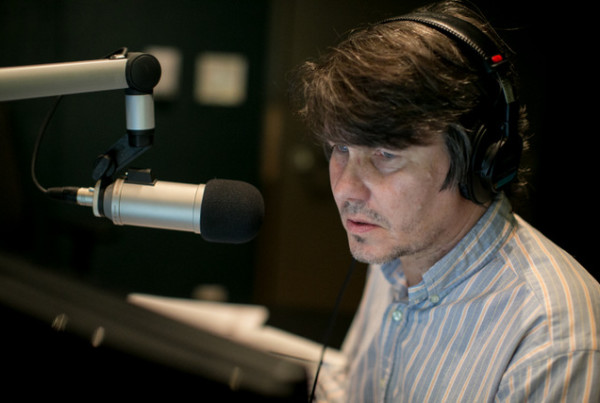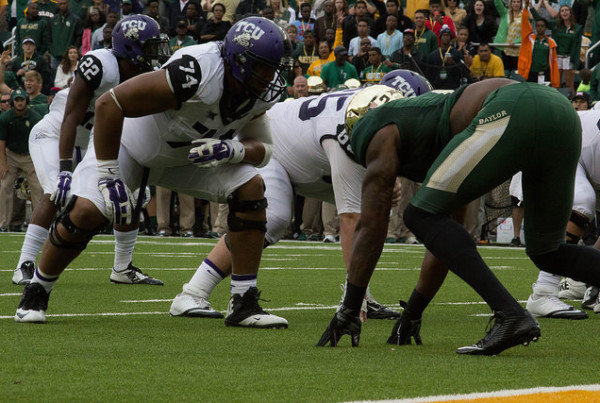This story originally appeared on Texas Public Radio. It’s the last in a four-part series.
In the pantheon of Texas football, few rank higher than former University of Texas coach Darrel Royal.
“As a smart aggressive teacher who believes in hard-nosed football, Royal has led Texas to new heights on the grid iron,” says a nameless announcer in a black-and-white coaching film from the early 1960s. In the film, a young Royal lays down the law when it comes to tackling:
“Seventy-five percent of tackling is moral, desire and courage. If a man likes to hit, the proper techniques can add the next 25 percent to make a really effective tackler,” Royal says in his Oklahoma drawl.
The Longhorn coach explains there’s only one way to bring down an opposing ball carrier. You need to use your head.
“If you tackle with your head and you miss you have two shoulders to fall back on. Sometimes you get a bonus too. You’re heads up. Your headgear is placed squarely on the ball and the runner fumbles,” he says in the film.
That film was shot decades before anyone involved in football worried about concussions. Today, another Daryl is in front of the camera giving football advice. Daryl Johnson is a former fullback for the Dallas Cowboys.
“There’s simply no denying that these are serious brain injuries that call for serious precaution. Every game and every practice you need to be following one simple rule when it comes to concussions; when in doubt, sit it out,” Johnson explains.
The video is available on the University Interscholastic League website. It highlights Johnson preaching the new gospel of “head safe football.” It also promotes a new way of tackling that, when done properly, should reduce the chances of a player getting a concussion.
“Keeping students safe in our competitions continues to be our number one priority,” said Jamey Harrison, Deputy Director of the UIL.
In 2011, concern about an epidemic of Texas high school concussions reached a boiling point. The legislature took action with then state Senator Bob Deuell, a medical doctor, leading the way.
“There has been increasing awareness of the dangers of sports concussions. For too long player who had suffered concussions were judged to have had their bell rung and were allowed to participate in athletic competition before they were ready. This can have far reaching effects leading to multiple concussions or even long term brain damage,” said Deuell in a hearing on the bill.
House Bill 2038 was also called Natasha’s Law, named for Natasha Helmick, who suffered numerous concussions while playing high school soccer. Testifying for the bill, Helmick explained what it’s like to live with a concussion.
“You feel dizzy. Anxiety is heightened and you feel disoriented. Your memory becomes fuzzy. You have headaches that become unbearable. I’ve been knocked out and couldn’t where I couldn’t recognize my coaches, my parents or even remember what day it was,” she said.
Under the law, Texas school districts had to form Concussion Oversight Teams. They would set the concussion standards for each school district and create a procedure for when student athletes with head injuries could return to play. Coaches would also be required to learn about the dangers of concussions and parents would have to sign a concussion acknowledgement form.
“There is a theory in Texas that we are doing enough through the concussion consortium legislation that was passed four years ago. Unfortunately it really doesn’t do anything to address the issue,” said Will Danes who is with the Brain Injury Association of America, Texas Division. Danes and others offer that Natasha’s Law was a good first step for high school sports concussion protection. But further steps are needed.
“The intention was good with the legislation but it’s not working it’s not doing enough. There’s no tracking system. Any district can report however they choose,” Danes said.
Texas Public Radio wanted to test that assertion that there’s no accurate tracking system for concussions in Texas high school sports. So Texas Public Radio compared concussion numbers at the UIL with those we gathered from just four San Antonio area school districts: San Antonio ISD, Northside ISD, Northeast ISD and Schertz-Cibolo-Universal City ISD.
To get the UIL numbers, Texas Public Radio had to file a Texas Open Records request.
What we learned is that in 2014 the UIL reported 295 concussions for high school athletes across Texas.
The four districts we contacted independently, however, reported 464 concussions – 169 more in just four districts than the UIL counted for the entire state.
So why is UIL’s concussion count so much lower?
Jamey Harrison, the Deputy Director of the UIL, acknowledged they don’t keep tabs on concussions statewide. They only collect concussion numbers from 263 schools in Texas.
“We currently collect from each chair of a UIL district executive committee. The chair person’s school is responsible for reporting football injuries during the regular season. One we get to the post season we require every football schools to report injuries,” said Harrison.
Another reason why the concussion count is so low at the UIL, is that they are only counting football injuries. Remember Natasha from Natasha’s Law? She played soccer.
“We need stricter guidelines in order to protect all of our athletes,” said Helmick.
After football, soccer is the second leading cause of high school concussions, particularly girls soccer.
Harrison said the UIL doesn’t count soccer concussions because Natasha’s law doesn’t require the UIL to track any concussions.
“We don’t have any new rules relating to the reporting of concussions.”
Harrison said they would have trouble collecting that information anyway.
“The collection of medical data is a very complex and complicated issue because you have medical and scientific methodology if you are going to use it in a scientific way. You also have to consider the implications of multiple laws including FERPA the federal educational right to privacy act and HIPPA,” he said.
Even so, TPR was able to collect those numbers from four San Antonio area school districts without violating anyone’s privacy.
Danes, of the Brain Injury Association, claims the UIL isn’t collecting the information because it doesn’t want to know how bad the concussion crisis is in Texas sports.
“We can’t fix it if we don’t know what we are trying to fix. I’m going to sit in front of you and argue that there are ten – twenty times the number of concussions coming off a football field in Texas that the UIL will say.”
The concussion count that Texas Public Radio uncovered appears to back that up.
















